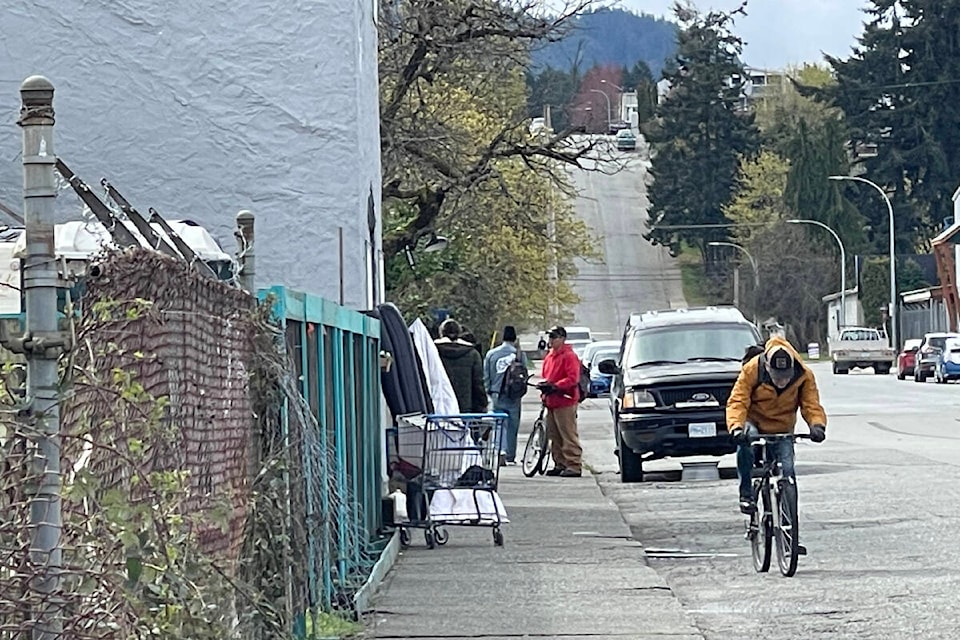Living in Port Alberni, you likely know the history of the tsunami that hit March 27, 1964 in the middle of the night. Many people—especially those living and working within the tsunami inundation zone—have a plan on where to go in an emergency.
But what about the city’s vulnerable population? Many of them live within the inundation zone, and that presents a challenge to the people tasked with saving them, says Heather Zenner, Alberni-Clayoquot Regional District’s protective services manager.
Vulnerable people are defined as those who cannot self-evacuate. That doesn’t solely mean people who are without homes, Zenner said. It also means seniors, people with mobility issues, people on low incomes who don’t have vehicles.
“It’s definitely one of the most challenging things with the tsunami inundation zone because a lot of the services that support the homeless population are in the inundation zone,” she said. Those include the overdose prevention site, Canadian Mental Health Association, the Port Alberni Friendship Center. “All those service providers need to support their vulnerable population but they also need to leave themselves.”
The emergency program encourages anyone living or working within the inundation zone to have a plan to get to high ground, and have someone ready to support them if they need to evacuate. “So say it was a senior with a disability or who has mobility issues in the inundation zone, we’d want them to have a family member know if there’s a reason to evacuate that they automatically go and help that one person.”
Emergency responders will be busy in the event of a natural disaster, she said.
Zenner can send out an early notification to service providers so they can enact their own emergency plans. There are several reception centres designated to open and accept people displaced by tsunami or other disaster. The ACRD Emergency Program will be able to access BC Transit buses to wherever people need to be evacuated.
Emergency program members liaise with the Canadian Mental Health Association and other agencies such as Kuu-us Crisis Line Society, Salvation Army and Bread of Life as part of their emergency response, she added.
“The homeless population is the most challenging because it’s about finding them,” said Katrina Kiefer, CMHA executive director. The CMHA has a plan to move people living in any of their housing within the inundation zone. For those people sleeping rough they have an outreach team whose members walk the streets building trust with the vulnerable population so they will be able to find them if they need to evacuate.
“We’ve got a system of communication between all the frontline workers…their job is to coordinate with each other…so we’ve got a general idea of our client base and our client list.”
Many of the agencies that provide assistance to the Alberni Valley’s most vulnerable people learned how to work together during the coronavirus pandemic, said Capt. Michael Ramsay of the Salvation Army. These agencies quickly formed a COVID-19 response team, and not only did it give them a way to communicate it also helped organizations network with one another to learn each others’ services.
Tsunami Preparedness Week “is a good opportunity for all of us to reflect, see what we’re doing and where we can do more,” he said.
The Salvation Army doesn’t have a specific response to help people leave the inundation zone during a tsunami warning. Their building is outside the zone, up the hill on Argyle Street. “Our response is to provide basic needs right after something like that would hit.”
Ramsay assured that every vehicle at the Salvation Army’s disposal would be put to use, providing meals, food, clothing, etc. to people affected by a disaster. “Spiritual care is also something our volunteers are trained to really try and help out with.”
While the Port Alberni Shelter Society has an emergency plan in place, there is always room for change, says Wes Hewitt, executive director. The PASS looks after the overdose prevention site at Third Avenue and Bute Street, and also has a food processing facility in the unit next door. A few blocks away, Phoenix House low-barrier housing and the sobering centre are at Fifth Avenue and Bute Street. All these buildings are within the tsunami inundation zone.
“With Third Avenue being non-residential our protocol is in case of a warning we shut down and send everyone up the hill,” Hewitt said. “For staff we marshal at the shelter (Our Home on Eighth),” which is well above the inundation zone.
The sobering centre would have to have an emergency plan in place because it operates under Island Health, he said, but he wasn’t sure if Phoenix House has an evacuation plan. Staff were tested last week when a fire broke out at the facility at 3:30 a.m., and within an hour displaced residents all had somewhere to sleep. The challenge, says Hewitt, is getting through to their clientele that there is immediate danger.
The PASS will be looking at their emergency plan and seeing how they can improve upon it, Hewitt said. The organization has participated in joint talks with other service agencies.
“Everything is a living document. What you’ve identified is we have to look at it.”
